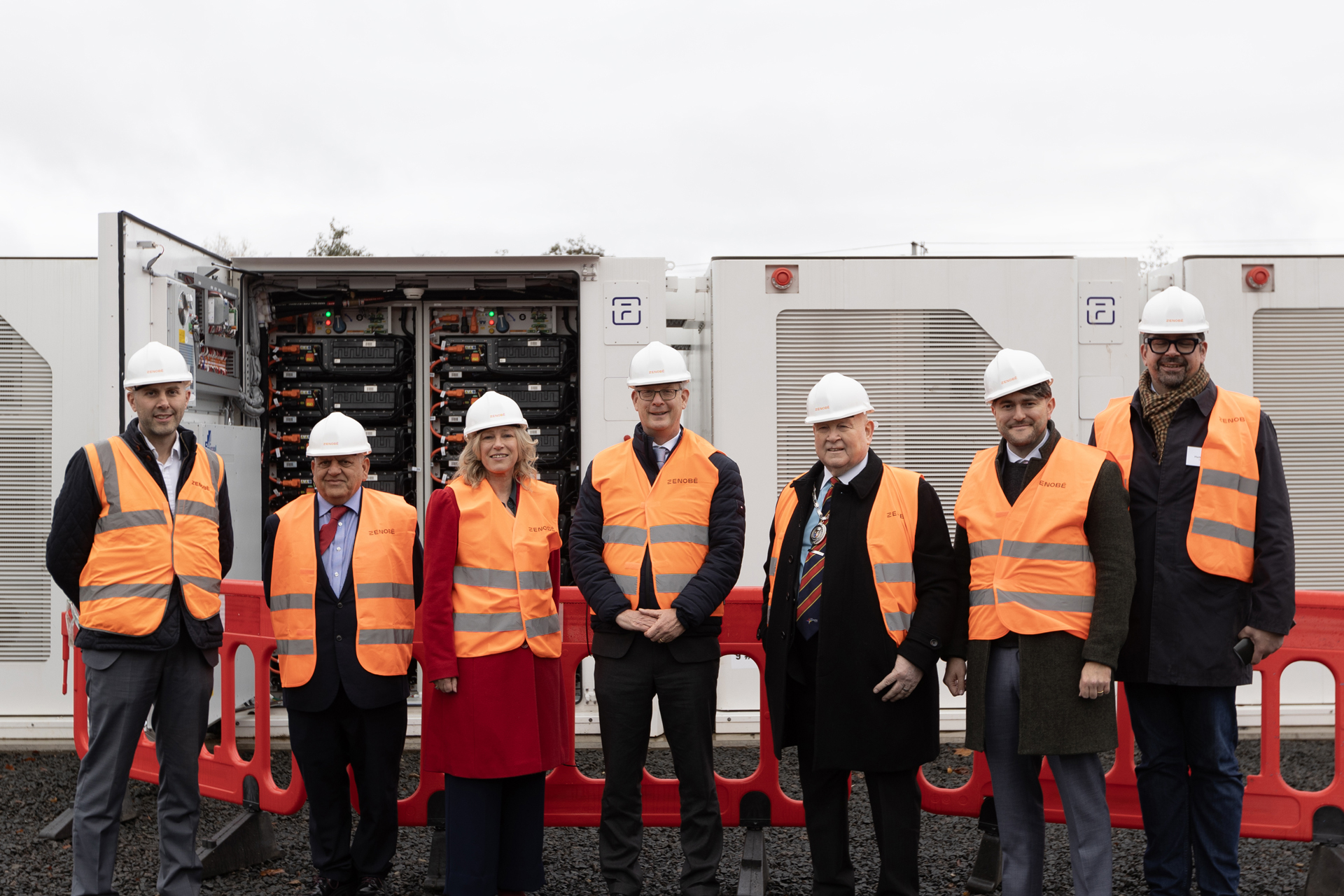New Zenobē battery storage site in Wishaw set to reduce renewable energy waste and significantly contribute to the doubling of Scotland’s energy storage capacity

15 November 2023
- The battery in Wishaw, North Lanarkshire will provide enough energy to power >500,000 homes in Scotland for two hours*, using electricity that would have otherwise gone to waste due to lack of capacity to store surplus wind power.
- At 50MW Wishaw is one of the largest batteries in Scotland, and the first to connect directly to the transmission network.
- The commissioning of the battery in Wishaw is the first phase of Zenobē’s £750 million commitment to double Scotland’s storage capacity in just three years.
- Wishaw is the first of the portfolio of grid-scale storage projects to come online, with others in Blackhillock, Kilmarnock South, and Eccles planned to come online by 2026.
Zenobē, a leading innovator in providing battery storage and fleet electrification solutions, today begins its journey to solve the UK’s problem of wasted renewable energy with the opening of its latest battery storage site in Wishaw, North Lanarkshire.
The site is the first of Zenobē’s £750 million portfolio of battery storage projects in Scotland to go live and will transform the country’s energy network by doubling its storage capacity in the next three years and supporting the acceleration of renewable energy in the UK.
The battery in Wishaw can store enough wind energy to power >500,000 homes for two hours* and will significantly curb the waste of homegrown renewable energy. So far this year, Great Britain has wasted 2,200 GWh of wind power – enough to have powered all the homes in Glasgow and Edinburgh for one year. Wastage occurs when wind turbines are paid to switch off due to a lack of network and storage capacity. By reducing the need to pay wind generators to switch off their turbines – known as curtailment costs – the Wishaw battery will pass on £41m in savings to consumers over 15 years. This represents a significant step in integrating renewable energy into the UK grid.
The 50MW battery in Wishaw is one of the largest ever constructed in Scotland and is the first to connect directly to the transmission network. It is the first of Zenobē’s pivotal storage projects to go live in Scotland, with projects in Blackhillock, Kilmarnock and Eccles due to come online within the next three years. The developer’s projects will collectively inject over 1 GW of storage capacity into Scotland’s energy grid by 2026.
Battery storage is an essential component in fortifying the UK’s energy security and reducing dependence on expensive fossil fuel energy. By capturing and storing wind energy, Zenobē enables homes, businesses and electric buses and trucks to be powered using clean power that would have otherwise been wasted.
The Wishaw site opening was commemorated with a launch event, attended by prominent stakeholders from the Scottish Parliament, including Scottish Energy Minister Gillian Martin, MSP for Aberdeenshire East as well as organisations from across the broader energy sector.
James Basden, Co-Founder of Zenobē, said:
“The Wishaw site inauguration represents a significant milestone for Zenobē and Scotland’s renewable energy ambitions as we seek to double Scotland’s storage power capacity.
“Battery storage is essential if the UK is to improve its energy security and bring down costs for consumers. By capturing and storing excess energy with sites like Wishaw, we can power homes, buses and trucks with energy that would otherwise have been wasted.
“Our recent successful capital raise provides the funding and Wishaw going live is the first step in this journey.
“We are pleased to work with our partners Fluence, Centrica, H&MV and Santander UK to deliver this project that will enable even more clean, renewable energy to flow safely and reliably through the electricity network to power homes and businesses in the wider Glasgow area and beyond.”
Gillian Martin MSP and Scottish Government Minister for Energy and the Environment said:
“The Scottish Government is committed to reaching net zero by 2045.
“Scotland has an abundance of renewable energy resources, but that has to be matched with the supporting infrastructure necessary to ensure that we can make the most of it.
“This major investment in storage facilities is already helping bring down energy bills and emissions and will play a crucial role in further decarbonising our energy system.”
This announcement follows Zenobē recently securing an investment of c.£600 million from KKR, a leading global investment firm, in addition to a further c.£270 million from existing shareholder Infracapital. This investment has enabled the business to accelerate its offering across the battery storage and EV fleet sectors and continue to expand globally across the UK and markets such as the US, Australia, New Zealand and more.
Notes to editors
Wasted wind
According to UK Wind Curtailment Monitor, Great Britain wasted 2.2 TWh of wind energy from January to September this year. The typical household uses 2,700 kWh per year, equivalent to 2,000 kWh over 9 months. Therefore 2.2 TWh is the equivalent to the electricity used by 1.1m homes (1.1m homes = 2,200,000,000 kWh / 2,000 kWh). 1.1 million, equivalent to Glasgow (600k) + Edinburgh (465k).
Consumer savings of £41m over 15 years reflects savings from providing balancing services and constraint management to the grid and helping reduce price volatility. This assumes that the asset cycles twice a day and provides a reasonable level of savings to the control room vs the alternative actions that would be taken e.g. curtailing wind for bid actions during constraints, more competitively priced offer actions than gas peakers / CCGTS. In addition, Wishaw has a Constraint Management Intertrip Service (CMIP) contract that will active until at least October 2025 and will enable ESO to curtail less renewable generation during constraints knowing that Wishaw will not contribute towards a post-fault constraint. The savings from the CMIP contract has not be captured in these calculated savings, but is likely to be significant and Zenobe hope the contract can be extended in some form throughout the 15 year project lifetime, which would lead to more consumer savings.
1GW of storage capacity – enough to power all homes in Scotland for two hours every day
Wishaw:
50 MW / 100 MWh live now
50 MW for 2 hours
Equivalent to >500,000 homes for 2 hours
Kilmarnock:
200 MW / 400 MWh live in 2024, 100 MW / 200 MWh live in 2025
At completion, 300 MW for 2 hours
Equivalent to 3.1m homes for 2 hours (at completion)
Blackhillock:
200MW / 400 MWh live 2024, 100MW / 200 MWh live in 2026
At completion, 300 MW for 2 hours
Equivalent to 3.1m homes for 2 hours (at completion)
Eccles:
400 MW / 800MWh
At completion, 400MW for 2 hours
Equivalent to 4m homes for 2 hours
There are 2.55m households in Scotland (source).
* Numbers were updated on 11/12/24, in-line with our most up-to-date reporting methodology. Learn more here.
For all media enquiries, please contact the Zenobē press office team:
Jaime Wright
E: zenobe@hillandknowlton.com
T: +44 (0) 7909 401 694
About Zenobē Energy Ltd. (Zenobē):
Zenobē is an EV fleet and grid-scale battery storage specialist, headquartered in the UK. The company began operations in 2017 with three founders and has over the past 6 years increased its staff to >230 FTEs with a wide range of leading skills including electrical engineering, software development, computer sciences and financing. It now operates in Europe and Australasia and is expanding into North America. Zenobē has 430MW of battery storage in operation or under construction with another 1.2GW of projects in advanced development in the UK which equates to circa 20% market share forecast by 2026. It has around 25% market share of the UK EV bus sector and c.1000 electric vehicles supported globally. The company is the largest owner and operator of EV buses in the UK, Australia and New Zealand.
Zenobe’s services are supported by market leading financing capability. This has included completing and drawing down against the Fleet private placement in February 2022 which raised over £240 million long term debt for the financing of Fleet customers, principally bus operators in the UK, over up to 16 years. This also included the financing of grid-scale batteries completed in February 2023 which raised £635m of debt including an accordion for the development of Zenobē’s grid-scale battery storage assets in Scotland.
For more information, please visit www.zenobe.com/ or follow on LinkedIn.
